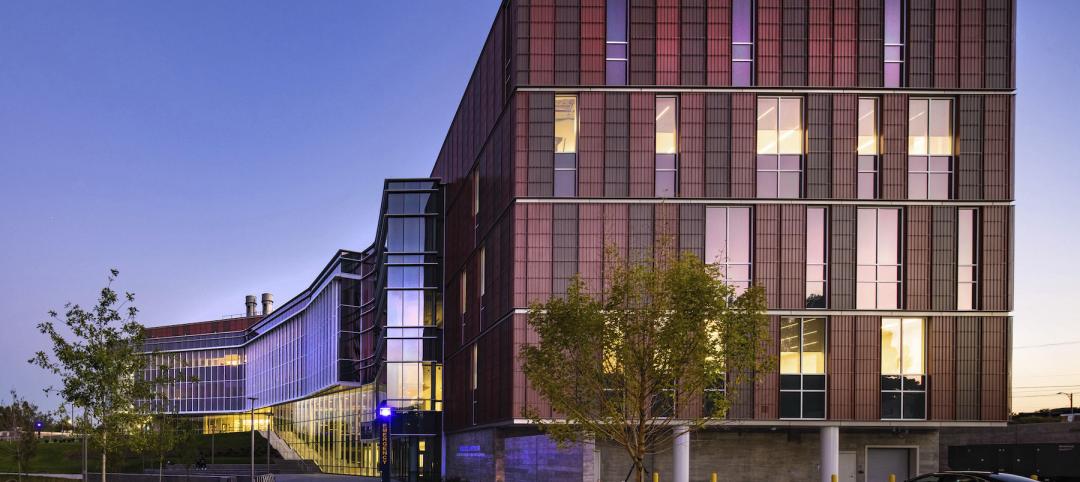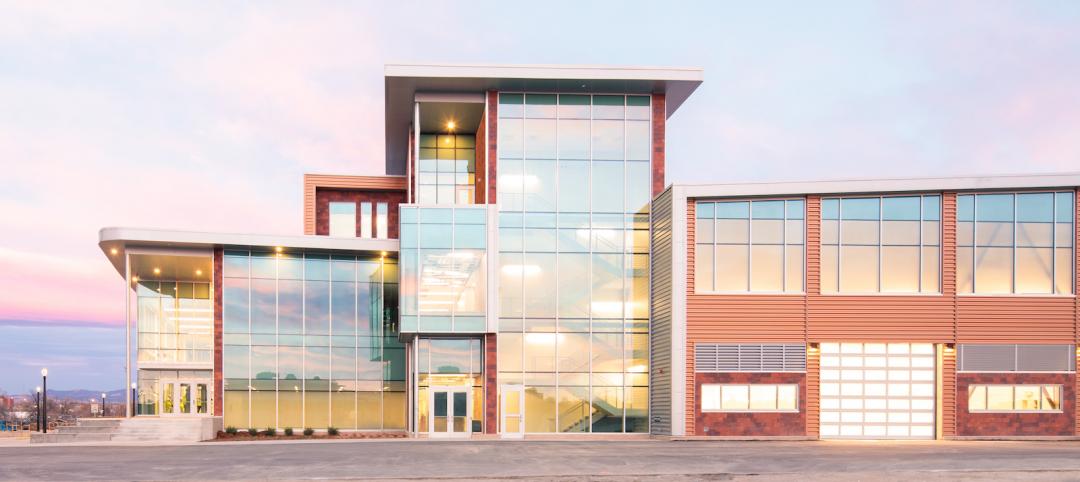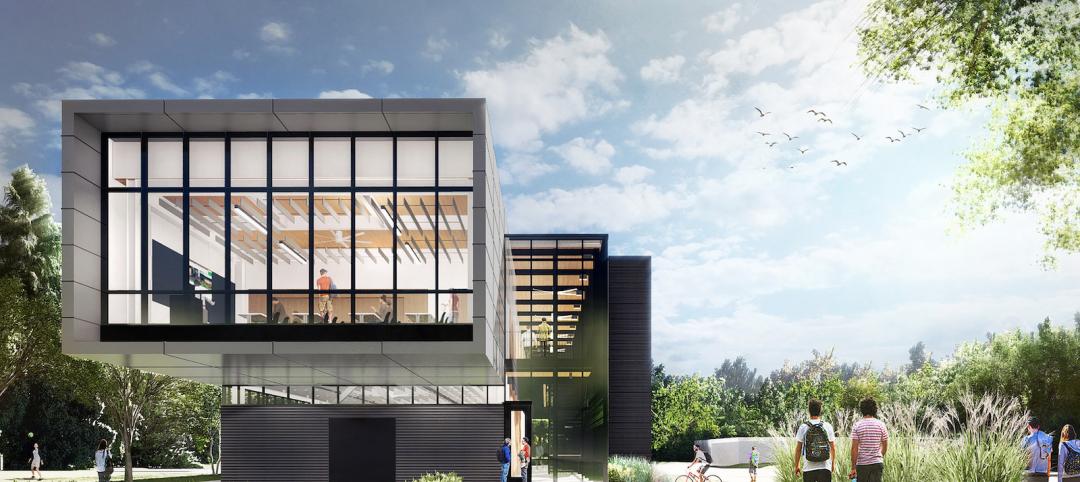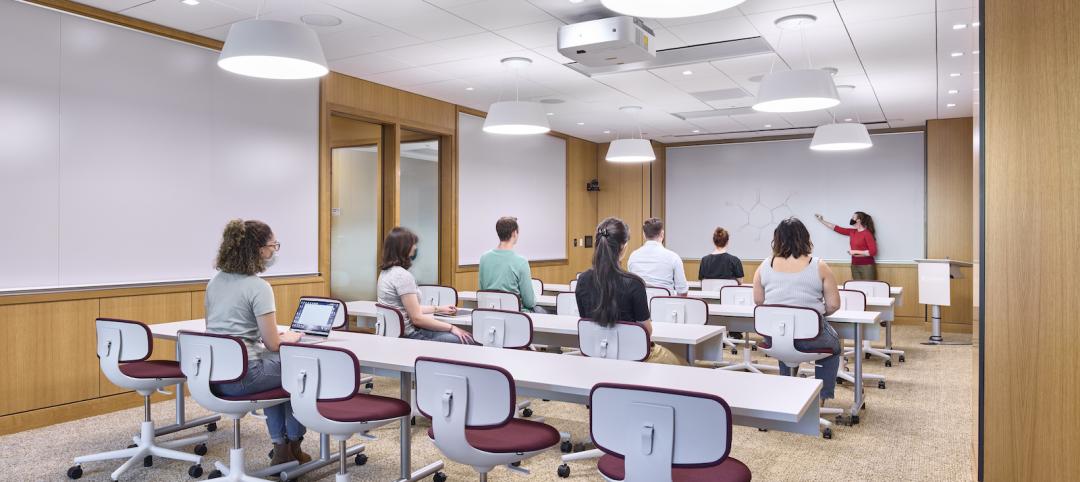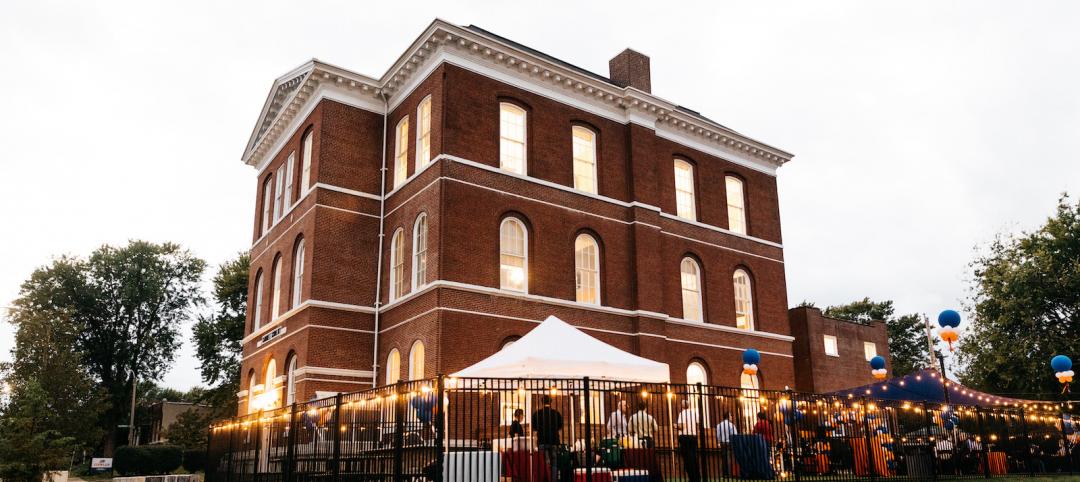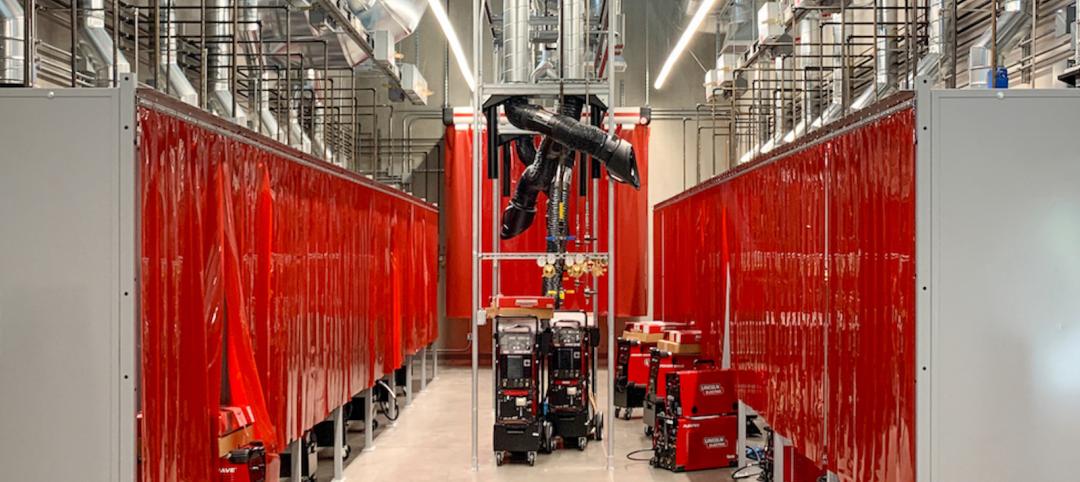
The city of Phoenix has sprawling suburbs, but its outward expansion caused the downtown core to stagnate—a problem not uncommon to other major metropolitan areas. Reviving the city became a hotbed issue for Mayor Phil Gordon, who envisioned a vibrant downtown that offered opportunities for living, working, learning, and playing.
The Mayor's plans for downtown redevelopment involved public-private partnerships, which led him to Arizona State University President Michael Crow. Crow was interested in expanding ASU's presence within the metro Phoenix area (ASU's main campus is in Tempe), so the city and school jointly developed a master plan for a new campus on nine city blocks. In 2006, voters approved $223 million in bonds, with $71 million slated for construction of the Walter Cronkite School of Journalism and Mass Communication, the new campus's first facility.
 |
| The two-story First Amendment Forum serves as the school’s “living room,” with a mezzanine level offering extra seating. Large windows between the forum and adjoining spaces, such as conference rooms and the Library & Student Resource Center, create a feeling that activities are always “on air.” |
The RFP for a design-build team was won by the alliance of HDR Architecture (executive architect), Ehrlich Architects (design architect), and Sundt Construction (GC) and required the team to adhere to an absolute fixed budget and a maximum 20-month timeline from award to occupancy certificate.
The Building Team utilized integrated project delivery and BIM to stay on time and on budget. Among other things, IPD and BIM enabled the Building Team to create detailed cost models instead of cost estimates, so that by the close of business every Friday the project budget was rectified.
IPD also helped with the fast-track schedule by allowing the project to be broken up into multiple packages, each with its own senior IPD leader and production team. The strategy allowed foundations to be poured before the superstructure design was complete and before the exterior skin was finalized. A special team was assigned to acquiring entitlements and building permits to accommodate the project's breakneck pace, and the city helped expedite the review process.
 |
| Studio spaces were built out quickly, but during interior improvements the floors received a top coating to create a camera-friendly flatness. |
The building's basic rectilinear form—a simple 30-foot-square exposed structural concrete column grid, burnished concrete block walls, and insulated cladding—was a practical choice for the project's budget and timeline. It enabled the Building Team to maximize square footage: ASU had a lengthy list of features they needed to squeeze into the six-story, 223,000-sf facility. The Walter Cronkite School of Journalism and Mass Communication is sandwiched between the building's ground floor, which houses the main lobby and retail and restaurant space, and the top floor, which is utilized by the city's PBS station, KAET/Channel 8. The university space includes 12 classrooms, seven working newsrooms, two state-of-the-art television studios, a library, a 150-seat theater-style auditorium, and a 1,500-sf exhibition gallery.
The centerpiece is a large “living room,” dubbed the First Amendment Forum. This two-story space—with mezzanine—is used as a gathering area for students during the day, while in the evening it becomes a public forum for students and industry leaders to engage in discussion and debate. Five hi-def flat-screen televisions and a large hi-def rear projector broadcast the day's news and other events. Walter Cronkite's famous sign-off, “And that's the way it is,” is inscribed on one wall.
To moderate the monolithic effect of the rectangular building, the Building Team sliced off a bit here and there and bumped out stairwells several feet from exterior walls. A combination of thin vertical and long horizontal windows, a wraparound exterior balcony, and multicolored corrugated metal cladding in a pattern inspired by FCC's radio spectrum chart further break up what could be a blocky exterior.
The facility opened in May 2008, and is adjacent to a pedestrian boulevard and across the street from a newly completed high-rise residence hall and a student union created by the adaptive reuse of a historic post office building. The city's new light rail system stops near the main entrance. The downtown now bustles with student life.
The project impressed Building Team Awards judge Dan Huntington. “Twenty months from start to certificate of occupancy on a building this size—that's pretty impressive,” says Huntington, SE, PE, LEED AP, associate principal at KJWW Engineering Consultants in Rock Island, Ill. “They had a very large task put in front of them, and they were very successful.”
Related Stories
Projects | Mar 16, 2022
Tomorrow’s STEM leaders get a state-of-the-art research complex
In February, North Carolina Agriculture and Technical State University (NC A&T) opened its new Engineering Research & Innovation Complex (ERIC).
University Buildings | Mar 7, 2022
A new facility can offer thousands of equine therapy sessions a year
At its new Spur campus in Denver, Colorado State University (CSU) will bring its expertise to the public by offering free educational experiences to visitors of all ages. Spur’s three buildings—Hydro, Terra, and Vida—will focus, respectively, on water, earth, and life.
Higher Education | Mar 1, 2022
SRG Partnership designs a nautically inspired space for maritime science
A community college in Oregon has begun construction on a new building devoted to maritime science. With it, the school hopes to solidify its position as a major industrial and marine technology center in the Pacific Northwest.
University Buildings | Feb 18, 2022
On-campus performing arts centers and museums can be talent magnets for universities
Cultural facilities are changing the way prospective students and parents view higher education campuses.
University Buildings | Feb 18, 2022
UPenn converts a library past its prime to a tech-integrated learning and maker
In September 2021, Penn reopened its renovated and expanded library as an open center for cross-disciplinary learning, prototyping, and collaboration. Now called Biotech Commons, the 17,000-sf building supports new modes of research by offering a range of spaces and services that is free to be scheduled by any student or faculty member.
University Buildings | Feb 17, 2022
A vacated school in St. Louis is turned into a center where suppliers exchange ideas
In 1871, The Carondelet School, designed by Frederick William Raeder, opened to educate more than 400 children of laborers and manufacturers in St. Louis. The building is getting a second lease on life, as it has undergone a $2 million renovation by goBRANDgo!, a marketing firm for the manufacturing and industrial sectors.
Education Facilities | Feb 17, 2022
Community colleges build new centers for advanced manufacturing training
Portland Community College joins a growing list of community colleges building advanced training facilities to help close the skills gap in manufacturing.
Resiliency | Feb 15, 2022
Design strategies for resilient buildings
LEO A DALY's National Director of Engineering Kim Cowman takes a building-level look at resilient design.
Coronavirus | Jan 20, 2022
Advances and challenges in improving indoor air quality in commercial buildings
Michael Dreidger, CEO of IAQ tech startup Airsset speaks with BD+C's John Caulfield about how building owners and property managers can improve their buildings' air quality.
University Buildings | Jan 11, 2022
Designing for health sciences education: supporting student well-being
While student and faculty health and well-being should be a top priority in all spaces within educational facilities, this article will highlight some key considerations.


